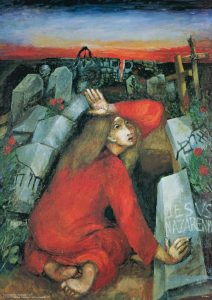FEAST OF MARY MAGDALENE
Becoming a New Creation
(Song of Songs 3:1-4a (or) 2 Cor 5:14-17; Ps 63; Jn 20:1-18)
******************************************************
The first mission to which I was assigned as a young Oblate priest was St. Mary Magdalene in Beauval, on the picturesque banks of the Beaver River. When we built a new church in 1984, we commissioned Al Gerritsen to carve a beautiful wooden mandala of Mary Magdalene face to face with Jesus that now graces the front of the building.

Appearance of Jesus to Mary Magdalene, Fr. Seiger Koder
This feast in honour of Mary Magdalene brings to mind a client at the Hopeview Halfway House in North Battleford, SK. for people in recovery who are going through a process of reintegration into society. She shared with me that she was addicted to alcohol, drugs, gambling and sex. As well, she lied, shopped and stole compulsively. After our conversation, it struck me that I had just met another Mary Magdalene who was letting go of all these personal demons and trying to heal through the 12 Step program.
This feast invites us to be like Mary Magdalene: To believe, to be humble, to be forgiven, to be healed and finally to be a witness to our encounter with Jesus.
Our process of change and transformation begins with faith in Jesus and his two-fold mission as the Messiah: to redeem and sanctify, to forgive and to heal. He came not just to forgive our sins but also to heal our sinfulness (that which makes us sin – our painful emotions, defects of character, negative attitudes and our addictions.
St Paul, in the optional first reading from 2 Corinthians, captures this transformation eloquently and passionately: “So if anyone is in Christ, there is a new creation: everything old has passed away; see, everything has become new!
That was the experience of Mary Magdalene who was delivered of seven demons by Jesus. It is no accident that St. John begins this passage about her with the words “Early on the first day of the week, while it was still dark, Mary Magdalene came to the tomb.” What was truly dawning was the awesome new creation that Jesus was bringing about by his passion, death, resurrection and the sending of the Spirit on the early church.
Mary Magdalene had become a new creation through her encounter with Jesus. She was transformed into a woman of the resurrection. It is rather astounding that a very troubled, sinful woman, whose life was a mess, would be chosen to be the first witness to the resurrection and “the apostle to the apostles.” Astounding, yes, but also fitting, for she, like King David and like the woman who had washed the feet of Jesus with her tears and wiped them with her hair, had been forgiven much, and were now able to show much love.
We have a very important choice as we celebrate together. We can leave the same as we came, armed with a bit more knowledge about Jesus, or we can depart as new creations ourselves, having been transformed by our experience of him through faith-filled prayer, humble forgiveness and profound healing. We are invited to be like Mary Magdalene, to believe, be humble, be forgiven, be healed, and then called to witness our experience to others.
The parable of the Pharisee and the publican or tax collector illustrates this choice. We could say that both went through the same retreat. The Pharisee, filled with pride and a judgmental spirit, and also caught in a web of blame and denial, prayed, but went home unchanged. The publican, on the other hand, believed in God’s love, humbly faced himself and his situation, received forgiveness and healing, and went home, the scriptures tell us, justified. We can choose to be one or the other. Hopefully we will all choose to see ourselves as tax collectors and go home transformed.
The Eucharist on this feast is another opportunity for us to be like Mary Magdalene – to celebrate with genuine faith; to humbly receive the forgiveness and healing of Jesus, to proclaim “we have seen the Lord” and also share how he has transformed us.
So let us be like Mary Magdalene: believe, be humble, be forgiven, be healed and be a witness to our transformation.



